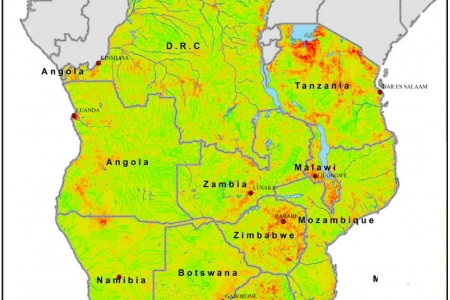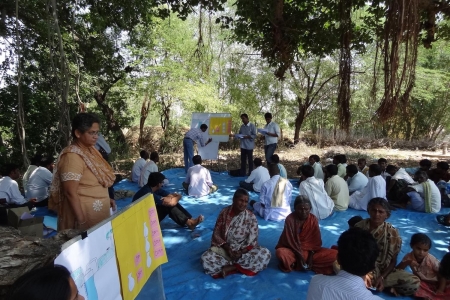Using groundwater for agricultural production has the potential to build resilience in food insecure regions of the world. Use of groundwater can boost agricultural production, improve rural incomes and strengthen farmers’ ability to withstand climate shocks and water variability. However, for groundwater to contribute to sustainable intensification of agriculture, it is essential to know where to invest in groundwater development and how to sustainably manage groundwater resources. WLE has identified potentially usable groundwater resources in Africa, supported important policy changes to enhance the sustainable use of groundwater in eastern India, and has developed maps and new tools that can be used to implement new policies supporting sustainable use of groundwater.
GROUNDWATER IRRIGATION TRENDS, POTENTIAL AND RISKS
Access to groundwater allows farmers to intensify and diversify their cropping systems, improve household food security and incomes, and shield against droughts. Over the past half century, groundwater has boosted agricultural production and underpinned agrarian transformation in large parts of Asia, North Africa and the Middle East.
Unsustainable use of groundwater, however, can have severe and long-lasting consequences for ecosystems and societies. Today, groundwater and its socio-economic benefits in both rural and urban areas are threatened due to pollution and overexploitation caused by indiscriminate land use and countless unregistered private wells.
Research that quantifies both the potential for, as well as the risks from, groundwater development, coupled with innovative management and policy solutions, can help guide sustainable groundwater use in the future.
Global
Groundwater currently supplies approximately 40% of the world’s irrigated area. It enables 13% of total food production, and groundwater contributes to about 44% of irrigated food production worldwide.[1]
While use of groundwater has significant potential for boosting future agricultural yields, food production in some regions of the world is increasingly causing groundwater resource depletion, meaning that abstraction rates exceed replenishment levels.
Globally, an estimated 14 to 17% of food produced with use of groundwater relies on unsustainably mining of groundwater resources. Regionally, dependence on depleting groundwater sources for food production is highest in South Asia, the OECD countries, East Asia, and the Near East and North Africa (MENA), where 15%, 16%, 21% and 25%, respectively, of total crop production from groundwater is unsustainable (Fig 1).
Fig. 1: Dependency on depleting groundwater resources for irrigated food production[1]
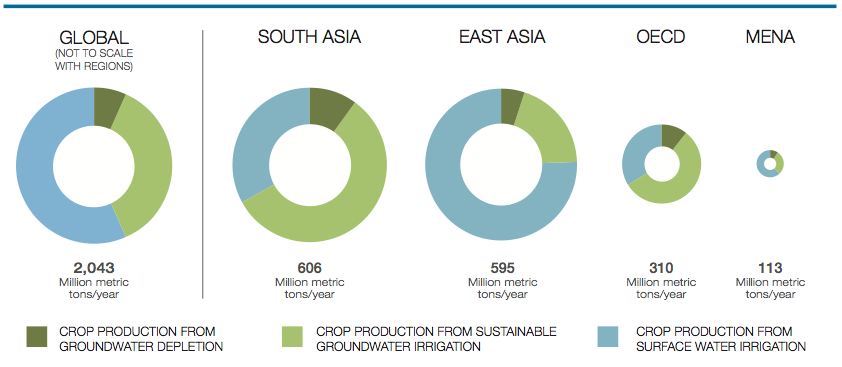
Overexploitation results in falling groundwater tables, deteriorating water quality, environmental degradation, rising pumping costs, and lower crop yields. Moreover, overdependence on depleting groundwater resources carries significant risks, compromising future food production and global food security as agricultural land becomes less or even nonproductive. These issues are increasingly discussed at national and international levels, such as at the Global Forum for Food and Agriculture.
To estimate where and how much groundwater can be sustainably abstracted, researchers have developed a methodology to calculate the contributions of surface and groundwater to environmental flows, i.e., the water flows required to sustain ecosystems. By considering how much groundwater supply is needed to maintain desired environmental flow conditions, this methodology can help deduce how much groundwater—globally and regionally—can be sustainably withdrawn annually (Fig. 2). These findings have formed the basis for an interactive tool that water managers can use to visualize and assess sustainable groundwater abstraction scenarios at various scales.[2]
Fig.2: Global groundwater that can be abstracted while sustaining current river ecosystems
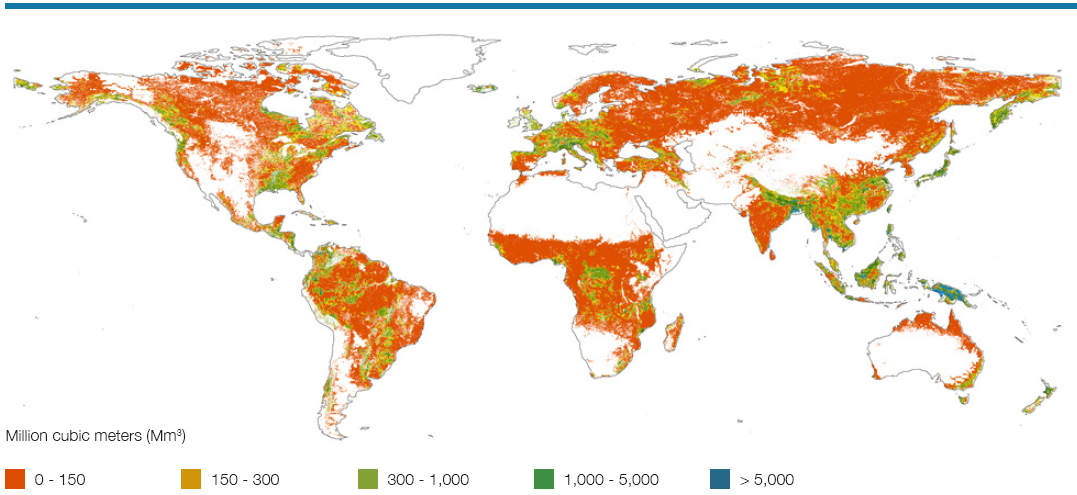
Africa
In Africa, only 1% of cultivated land (some 2 million ha) is currently irrigated using groundwater, and appreciable hydrological potential exists for groundwater irrigation across much of the continent. A series of continental-scale maps identifies, for the first time, the irrigation potential of areas with renewable groundwater resources, after accounting for human and environmental demand. The maps suggest that the area irrigated with groundwater could be expanded by a factor of 20, from the current 2 million ha to 40 million ha. In particular, the semi- arid Sahel and the eastern regions, stretching from Ethiopia to Zimbabwe, may represent significant unexploited opportunities for groundwater irrigation (Fig. 3). However, in southern and northern Africa, significant parts of the region have exhausted the potential for development of sustainable groundwater irrigation.[3]
Fig.3: Irrigation potential for areas with renewable groundwater resources in Africa
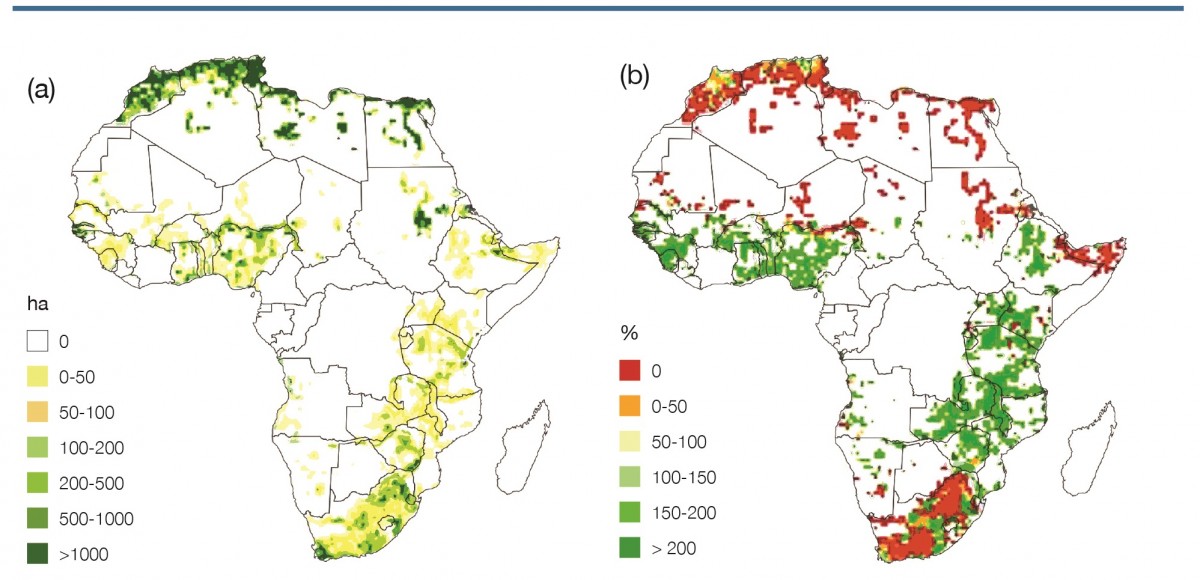
(a) Actual area irrigated with groundwater in 2005 expressed in ha. per cell[4]
(b) Groundwater irrigation potential for the year 2000 expressed as the percentage of the area irrigated with groundwater in 2006[3]
Groundwater may also be susceptible to drought, e.g., where groundwater storage is limited, meteorological drought risk is high and where population density and groundwater dependency are relatively high for both domestic and productive purposes. Up to 40 million people in southern Africa may already be vulnerable to groundwater drought, with greater risk expected in the years to come as climate change impacts intensify.[5] Finally, advances in mapping technology and international water cooperation have provided more detailed knowledge on the extent of transboundary aquifers in Africa. Recent maps identify 80 shared aquifers and aquifer systems superimposed on 63 international river basins. Nearly a third of the continent’s population lives within the hydrological boundaries of these shared aquifers, which cover approximately 42% of continental Africa’s land area.[6] The maps, and complementary training materials, respond to an expressed need from African decision makers to strengthen the integration of transboundary groundwater issues into river basin management. Scientists have provided mapping tools and capacity building on transboundary aquifer management, helping to improve cooperation between Botswana and South Africa in relation to their shared groundwater resource, the Ramotswa Aquifer.
Together, this research and the related tools can help investors and policy makers decide where and how to sustainably invest in groundwater development in Africa to achieve food security, livelihood improvements and climate resilience.
Asia
In Asia, groundwater irrigation accounts for approximately 14% of cultivated land (about 38 million ha)[3], and Asian groundwater-irrigated areas account for 70% of groundwater-irrigated areas globally. The region portrays a mixed picture of both areas with potential for future growth in groundwater use, and areas where groundwater is already overexploited.[7]
India presents both of these two scenarios. With an estimated 20 million wells, groundwater supplies more than half of all the irrigated area in the country. Groundwater use in India has grown phenomenally during the past five decades, particularly in the arid to semi-arid regions in southern and western India, which has led to unsustainable exploitation (Fig. 4). By contrast, in large parts of northeastern India, where rainfall is plentiful and groundwater development is less than recharge, there is significant potential for sustainable groundwater development.[8]
These contrasting settings underscore the need to identify interventions that fit the prevailing context. Long-term research in India provides insights into the range of policy and management options that exist to sustain groundwater irrigation, including by encouraging groundwater use in regions with largely abundant supplies while incentivizing conservation in water-scarce regions. See below for an example of how policy change is being used to promote optimal groundwater use in West Bengal.
Fig.4: Groundwater development by district in India[9]
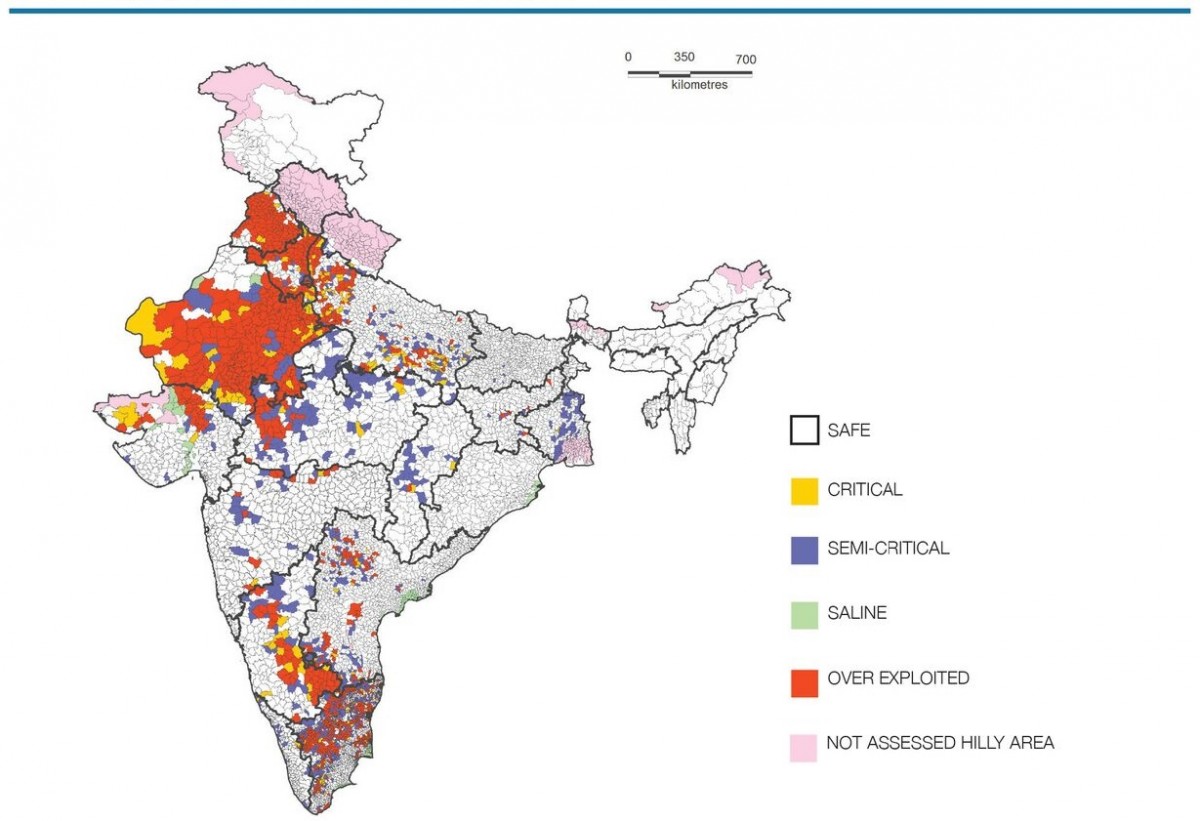
Furthermore, managing India’s groundwater in a sustainable manner requires more than knowledge about the hydrogeology of aquifers; it also requires an understanding of larger political and social institutions that influence decision making on land use, cropping and groundwater use. For example, while in the United States less than 2% of the population uses about 200 km3 groundwater annually, drawn from 400,000 wells, more than 50% of the population in India uses nearly the same amount of groundwater, drawn from more than 20 million wells.[7] This plurality makes for a much more complex groundwater economy, which is why India has been the focus of much research on policies and institutions for sustainable management of groundwater resources.
POLICY AND MANAGEMENT SOLUTIONS FOR SUSTAINABLE GROUNDWATER USE
Groundwater use in agriculture is soaring in arid and semi-arid regions around the world. Never before has as much groundwater been pumped for irrigation, industry and urban development. The challenge is to craft policy and management interventions that support its sustainable use in often widely contrasting socio-economic and institutional contexts. Groundwater is an invisible resource, literally hidden below ground. The unclear boundaries of the aquifers and the limitations on their sustainable use translate into risks for indiscriminate use and confound traditional institutional arrangements for common resource management. Therefore, sustainable use requires assessing, and in some cases revising, current groundwater policies as well as exploring potential cross-sectoral solutions.
Optimizing groundwater policies to boost sustainable groundwater use
In some cases, well-intended but misinformed policies stand in the way of effective groundwater use. In the eastern Indian state of West Bengal, for example, seasonal rainfall is plentiful, but groundwater is largely underused. However, the state instituted groundwater legislation in the mid-2000s, requiring farmers to apply for permits to use electric tube well pumps, based on the assumption that it was necessary to preserve the state’s groundwater resources and track the number of wells. Consequently, poor farmers, with limited access to electricity connections and electric pumps, hired expensive diesel pumps, and agricultural growth slumped from around 5% per year in the 1980s and 1990s to under 2% in the 2000s. A few years later, scientists, together with state officials, reviewed changing policies to reflect the actual abundance of groundwater in the state. The final result was a policy change in 2011, based on the research recommendations, to relax the electric pump licensing process and introduce a flat electric connection fee for farmers in water-abundant areas to encourage smallholders to use the available water to boost agricultural productivity. These changes resulted in over 140,000 new electric connections for tube wells, which improved irrigation on 250,000 ha for approximately 1.3 million, mostly smallholder, water users. This led to greater net returns, improved water quality and higher-value outputs. Researchers and officials are now revisiting the policy to see if any further modifications are needed to safeguard the state’s groundwater resources.[10]
Managing groundwater via incentives from the energy sector
Incentives for sustainable groundwater irrigation can lie outside the water sector. In India, for example, the introduction of farm power subsidies in the 1970s led to depletion of groundwater resources in the western and south-central parts of the country, where groundwater is crucial for crop water requirements and where most farmers have electric connections. More recently, solar power has been introduced as a more versatile, green alternative to electric pumps that can form part of a climate change mitigation strategy. But, without carefully designed programs, they could further threaten groundwater sustainability because of the dramatic reduction in the cost of pumping. Therefore, the local electricity company in Karnataka state is required to buy back surplus solar power from farmers, thus treating solar power as a ‘cash crop.’ The rationale is that if farmers can make money by selling excess power, then they have an economic incentive to irrigate their crops efficiently, thus helping to conserve groundwater and energy use.
Solarizing India’s electric tube wells could reduce carbon emissions by 4-5% per year. Researchers are piloting such a ‘smart solar pump’ model in Anand district in the State of Gujarat where the world’s first solar cooperative has been formed, enabling the utility company to buy back excess solar power at lower transaction costs, compared to purchasing power from individual farmers. If scaled up, the model offers a promising opportunity to improve agricultural productivity and profitability, decrease the demand for energy from fossil fuels and reduce carbon emissions, all while ensuring sustainable groundwater use[9] (Fig. 5).
Fig.5: Solar energy used in irrigation and sold to the grid by the Dhundi Cooperative in India[9]
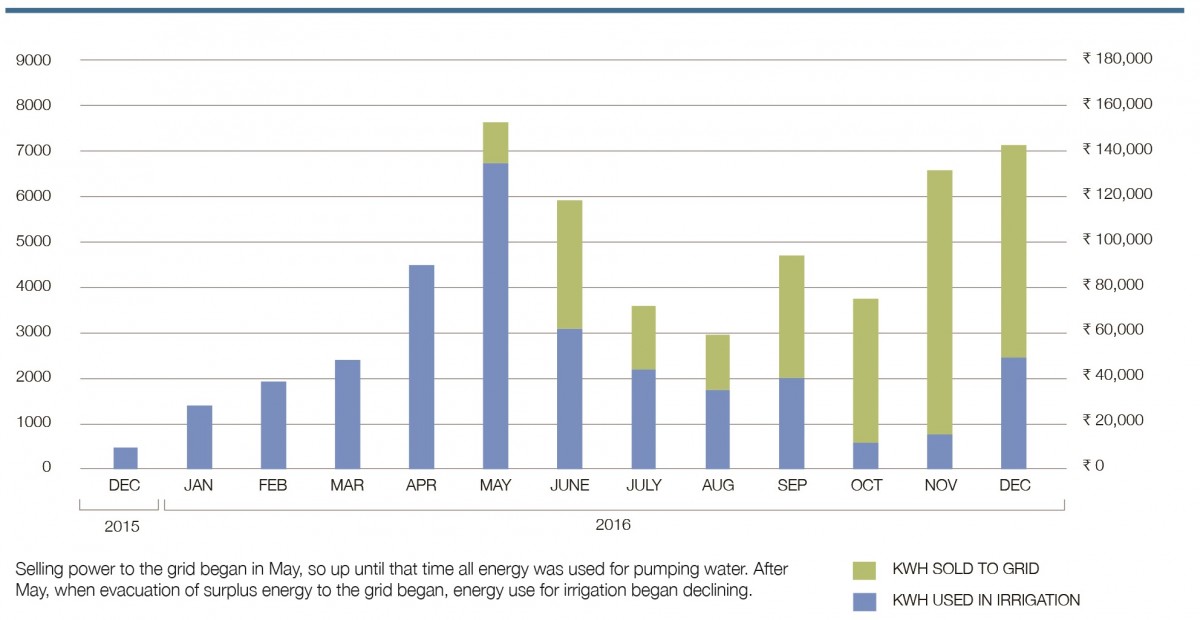
Supporting urban aquifers via inter- sectoral water transfers
To address the significant challenges urbanization places on aquifers and their management, researchers are analyzing the business of rural- urban water transfers and aquifer recharge with wastewater. In Bangalore, India, urban wastewater is directed to peri-urban tanks (reservoirs) for groundwater recharge, thus revitalizing reservoirs that have been dry for more than 18 years, and making groundwater accessible again for peri- urban and urban users. The same trend is emerging in many other places around the world, such as in the Llobregat delta near Barcelona in Spain and in the Mashhad plain in Iraq, where farmers and the city swap freshwater against treated wastewater, while wastewater also replenishes the aquifer used by the city. Researchers are exploring models such as these to understand the enabling conditions, institutional linkages and incentive systems that would encourage inter-sectoral transfers of wastewater in safe and sustainable ways.
Enhancing community management through experimental games
There are many successful models for managing common pool resources, particularly in relation to forests, protected areas and even surface irrigation. But, for groundwater there is a notable lack of proven models. However, in Andhra Pradesh, India, researchers have piloted experimental games to help water users understand the social and biophysical contextual variables that affect how farmers work together to solve groundwater challenges. Despite many aquifers being overexploited in this part of India, farmers have so far not been cooperating on regulating groundwater use. Researchers found that farmers’ inability to collectively manage groundwater was due in part to a lack of information: many farmers reported they thought that groundwater levels were mostly affected by rainfall and had not understood that selecting crops that require a lot of water can also contribute to depleting aquifers. The experimental games helped make explicit this connection. The games have proved to be a useful entry point for discussion among community members on how cooperation can help improve water management.[11]
CONCLUSIONS
Use of groundwater in agriculture has increased agricultural production, improved incomes and contributed to food security. However, to maintain and extend these achievements, and to prevent groundwater depletion or degradation, greater knowledge of groundwater resources as well as policy and management options are required.
WLE researchers have developed tools that water managers and investors can use to identify where and how to sustainably develop groundwater. WLE also supports transboundary aquifer management to strengthen the role of shared groundwater resources in enhancing water security.
However, serious groundwater overexploitation also exists, particularly in parts of Asia. Addressing this requires an understanding of institutional, hydrogeological and stakeholder contexts, at all levels, and of how to develop the incentives that enables sustainable abstraction, without causing undue impacts on socio-economic development and equitable access. Critically, solutions cannot be viewed in single-sector policy arenas - the energy sector for example has had a large impact on groundwater use in India and is increasingly being leveraged to support sustainable groundwater use.
WLE has provided significant new knowledge that will support sustainable investments in groundwater, food security and environmental services across Africa and Asia. Future areas of work will focus on improving understanding of how groundwater quality contributes to sustaining healthy environments, livelihoods and diets. Protecting and remediating the resource for improved water security and sanitation in peri-urban areas will also be a future focus.
Other new areas of work include efforts to improve understanding of how groundwater is replenished, such as the interlinkages between groundwater and surface water for improved integrated management.
WANT TO GET A GRIPP ON GROUNDWATER?
The Groundwater Solutions Initiative for Policy and Practice (GRIPP) is a global partnership, hosted and coordinated by the International Water Management Institute (IWMI), that aims to strengthen, expand and connect current groundwater initiatives. Building on three decades of research, as well as initiatives like the GW-Mate initiative under the World Bank and the Groundwater Governance Project, it seeks to embed sustainable groundwater practices at the heart of natural resource management and the Sustainable Development Goals. Interested parties can learn more here: https://gripp.iwmi.org/.

Acknowledgements
The team acknowledges the contributions and efforts of Meredith Giordano (Principal Researcher, IWMI), Douglas Merrey (independent consultant), and Alexandra Evans (independent consultant) in preparing the content for this series; and Caroline Holo (intern), Miles Bell (intern) and Aishwarya Venkat (intern) for their assistance with literature and data collection. We would also like to acknowledge the support of WLE scientists and partners in the preparation and review of the briefs. This research was supported by CGIAR Fund Donors.
References
-
1.
Villholth, K.G.; Sood, A.; Liyanage, N.; Zhu, T. Forthcoming. The role of groundwater and depleting aquifers in global irrigated food production. Nature Communications.
-
2.
Sood, A.; Smakhtin, V.; Eriyagama, N.; Villholth, K.G.; Liyanage, N.; Wada, Y.; Ebrahim, G.Y.; Dickens, C. 2017. Global environmental flow information for the sustainable development goals. Colombo, Sri Lanka: International Water Management Institute (IWMI). 37p. (IWMI Research Report 168).
-
3.
Altchenko, Y.; Villholth, K.G. 2015. Mapping irrigation potential from renewable groundwater in Africa – a quantitative hydrological approach. Hydrology and Earth System Sciences 19(2): 1055-1067.
-
4.
Siebert, S.; Burke, J.; Faures, J.M.; Frenken, K.; Hoogeveen, J.; Döll, P.; Portmann, F.T. 2010. Groundwater use for irrigation–a global inventory. Hydrology and Earth System Sciences 14: 1863- 1880.
-
5.
Villholth, K.G.; Tøttrup, C.; Stendel, M.; Maherry, A. 2013. Integrated mapping of groundwater drought risk in the Southern African Development Community (SADC) Region. Hydrogeology Journal 21(4): 863-885.
-
6.
Altchenko, Y.; Villholth, K.G. 2013. Transboundary aquifer mapping and management in Africa: A harmonised approach. Hydrogeology Journal 21(7): 1497-1517.
-
7.
Shah, T. 2014. Groundwater governance and irrigated agriculture. Stockholm, Sweden: Global Water Partnership Technical Committee. 69p. (TEC Background Papers 19).
-
8.
Bird, J.; Dodds, F.; McCornick, P.; Shah, T. 2014. Water–food–energy nexus. In: On target for people and planet: Setting and achieving water-related sustainable development goals, eds., van der Bliek, J.; McCornick, P.; Clarke, J. Colombo, Sri Lanka: International Water Management Institute. Pp. 9-12.
-
9.
Shah, T.; Durga N.; Verma, S.; Rathod, R. 2016. Solar Power as a Remunerative Crop. Colombo, Sri Lanka: International Water Management Institute. (IWMI Tata Water Policy Highlight 10). 8p.
-
10.
Buisson, M-C. 2015. What does pump sets electrification change? Impacts on cropping patterns, productivity and incomes in West Bengal. Paper presented at the ICID 26th Euro-Mediterranean Regional Conference and Workshops on Innovate to Improve Irrigation Performances. Workshop: Irrigation and Energy, Montpellier, France, October 12-15, 2015. 5p.
-
11.
Meinzen-Dick, R.; Chaturvedi, R.; Domènech, L.; Ghate, R.; Janssen, M.A.; Rollins, N.D.; Sandeep,K. 2016. Games for groundwater governance: field experiments in Andhra Pradesh, India. Ecology and Society 21(3): 38.
Further reading
Altchenko, Y.; Awulachew, S.B.; Brida, A.B.; Diallo, H.A.; Mogbante, D.; Pavelic, P.; Tindimugaya, C.; Villholth, K.G. 2011. Management of groundwater in Africa including transboundary aquifers: implications for meeting MDGs, livelihood goals and climate change adaptation. Addis Ababa, Ethiopia: United Nations Economic Commission for Africa (UNECA). 24p. (African Climate Policy Centre Working Paper 6).
CGIAR Research Program on Water, Land and Ecosystems (WLE). 2016. Can groundwater irrigation be a “triple win” for smallholder African farmers?
CGIAR Research Program on Water, Land and Ecosystems (WLE). 2016. Games for Sustainability.
CGIAR Research Program on Water, Land and Ecosystems (WLE). 2015. Potential for sustainable groundwater irrigation in Africa: A development perspective. Colombo, Sri Lanka: International Water Management Institute.
CGIAR Research Program on Water, Land and Ecosystems (WLE). 2014. Sunshine: India’s new cash crop.
CGIAR Research Program on Water, Land and Ecosystems (WLE). 2014. Transboundary aquifer mapping and management in Africa. Colombo, Sri Lanka: International Water Management Institute (IWMI). 8p.
Closas, A.; Molle, F. 2016. Groundwater governance in the Middle East and North Africa region. Cairo, Egypt: IWMI; United States Agency for International Development. (IWMI project publication. Groundwater governance in the Arab world. Report no. 1).
Closas, A.; Villholth, K. 2016. Aquifer Contracts: A Means to Solving Groundwater Over-exploitation in Morocco? Colombo, Sri Lanka: International Water Management Institute. (GRIPP Case Study Series 1).
Ebrahim, G.Y.; Villholth, K.G. 2016. Estimating shallow groundwater availability in small catchments using streamflow recession and instream flow requirements of rivers in South Africa. Journal of Hydrology 541: 754-765.
Foster, S.; Tyson, G.; Konikow, L.; Custodio, E.; Villholth, K.; van der Gun, J.; Klingbeil, R. 2015. Food Security and Groundwater. International Association of Hydrogeologists. (Strategic Overview Series).
Ghosh, D.K.; Wang, D.; Zhu, T. 2015. On the transition of base flow recession from early stage to late stage. Advances in Water Resources 88: 8-13
International Water Management Institute (IWMI). 2016. Groundwater Solutions Initiative for Policy and Practice (GRIPP): A global partnership for sustainable groundwater management
International Water Management Institute (IWMI). 2016. SPaRC’ing a Revolution. A five-minute introductory video.
International Water Management Institute (IWMI). 2014. Regional Groundwater Drought Risk in the Southern African Development Community (SADC) Region.
Karimov, A.; Smakhtin, V.; Mavlonov, A.; Borisov, V.; Gracheva, I.; Miryusupov, F.; Djumanov, J.; Khamzina, T.; Ibragimov, R.; Abdurahmanov, B. 2013. Managed aquifer recharge: the solution for water shortages in the Fergana Valley. Colombo, Sri Lanka IWMI 51p. (IWMI Research Report 151).
Kishore, A.; Shah, T.; Tewari, N.P. 2014. Solar irrigation pumps: Farmers’ experience and state policy in Rajasthan. Economic and Political Weekly 49(10): 55-62.
Meinzen-Dick, R. et al. 2014. Games for Groundwater Governance: Field Experiments in Andhra Pradesh, India. Phoenix, United States: Center for the Study of Institutional Diversity. (CSID Working Paper Series #CSID-2014-006).
Mekonnen, D.; Siddiqi, A.; Ringler, C. 2016. Drivers of groundwater use and technical efficiency of groundwater, canal water, and conjunctive use in Pakistan’s Indus Basin Irrigation System. International Journal of Water Resources Development 32(3): 459-476.
Mukherji, A. 2013. Strategies for Managing India’s Groundwater.
Mukherji, A.; Shah, Tushaar; Banerjee, P. S. 2016. Kick-starting a second green revolution in Bengal. In Shah, M.; Vijayshankar, P. S. (Eds.). Water: growing understanding, emerging perspectives. New Delhi, India: Orient BlackSwan. pp. 483-489. (Readings on the Economy, Polity and Society)
Pavelic, P.; Giordano, M.; Keraita, B.; Ramesh, V.; Rao, T. (eds.). 2012. Groundwater availability and use in Sub-Saharan Africa: a review of 15 countries. Colombo, Sri Lanka: International Water Management Institute (IWMI).
Pavelic, P.; Villholth, K.G.; Verma, S. (eds.). 2013. Sustainable Groundwater Development for Improved Livelihoods in Sub-Saharan Africa. Water International 38(4): 363-503 (part 1); 38(6): 790-863 (part 2)
Scott, C.A.; Crootof, A.B.; Thapa, B.; Shrestha, R.K. 2016. The water-food-energy nexus in the Ganges Basin. In: Bharati, L.; Sharma, B.R.; Smakhtin, V. (eds.) The Ganges River Basin: Status and Challenges in Water, Environment and Livelihoods. London, UK: Routledge.
Shah, T.; Durga N.; Verma, S.; Rathod, R. 2016. Solar Power as a Remunerative Crop. Colombo, Sri Lanka: International Water Management Institute. (IWMI Tata Water Policy Highlight 10).
Villholth, K.G. 2015. Reconciling climate change and transboundary groundwater management for sustainable agricultural production. In: Hoanh, C.T.; Smakhtin, V.; Johnston, R. (eds.). Climate Change and Agricultural Water Management in Developing Countries. Centre for Agriculture and Biosciences International (CABI). ISBN 978-1-78064-366-3.
Villholth, K.G. 2015. Solutions – Groundwater drought risk in sub-Sahara Africa.
Villholth, K.G. 2013. Groundwater irrigation for smallholders in Sub-Saharan Africa – a synthesis of current knowledge to guide sustainable outcomes. Water International 38:4: 369-391.
Villholth, K.G.; Altchencko, Y. 2015. Solutions – Transboundary Aquifer Map for Africa.
Villholth, K.G.; Altchenko, Y. 2016. Is groundwater the key to increasing food security in Sub Saharan Africa?
Windham-Wright, T. 2015. Tapping into Africa’s groundwater potential.

